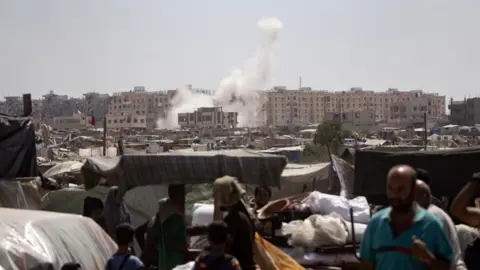 EPA
EPAUS Secretary of State Anthony Blinken has arrived in Israel in his latest effort to press for a Gaza ceasefire and hostage release deal.
His ninth visit to the region since the war began in October comes days after the United States presented a revised plan aimed at bridging the long-standing rift between the two sides.
The US and Israel have expressed hope for a deal since talks resumed in Doha last week, but Hamas says suggestions of progress are an “illusion”.
Among the differences is whether Israeli troops should withdraw completely from the Gaza Strip, as Hamas insists.
Mr Blinken is trying to keep the pressure on the Israeli leader – who will say now is the time to squeeze out the last concessions and abandon efforts to strike a deal.
On the way here a senior US official was using phrases including critical moment and inflection point.
The Americans hope to wrap it up as soon as this time next week.
But neither the Israeli leadership nor Hamas share that level of confidence.
Each accuses the other of stubborn cynicism and blocks a deal.
In a statement on Sunday, Hamas accused Israeli Prime Minister Benjamin Netanyahu of putting “obstacles” in the way of a deal and “setting new conditions and demands” aimed at “prolonging the war”.
It held him “fully responsible” for thwarting the mediators’ efforts and “blocking the agreement”.
Formerly a Hamas source The plans also include the IDF maintaining a reduced presence in the Philadelphia Corridor, a narrow strip of land along Gaza’s southern border with Egypt, the Saudis told media.
But Israeli sources told The Times of Israel Other procedures at the border will compensate for the withdrawal from Israeli territory in the first phase of the agreement.
The Israeli military launched a campaign in Gaza to wipe out Hamas in response to an unprecedented attack on southern Israel on October 7, during which approximately 1,200 people were killed and 251 taken hostage.
More than 40,000 people have been killed in Gaza since then, according to the territory’s Hamas health ministry.
A cease-fire deal agreed in November included the release of 105 Hamas hostages in exchange for a week-long ceasefire and the release of 240 Palestinian prisoners in Israeli prisons. Israel says 111 hostages are still being held, 39 of whom are presumed dead.
US President Joe Biden said earlier this week that “we are closer than we’ve ever been” to a deal.
But earlier optimism expressed in months of talks has proved unfounded.
At a cabinet meeting on Sunday, Mr Netanyahu said complex negotiations for the return of the hostages were underway, but that certain principles had to be adhered to for Israel’s security.
“There are things we can be flexible about, and there are things we can’t be flexible about, and we emphasize them. We know very well how to differentiate between the two,” he said.
He accused Hamas of being “stubborn” in negotiations and called for more pressure to be put on the militant group.
A senior Hamas official told the BBC on Saturday: “What we got from the mediators was very disappointing. There was no progress.”
Public statements of boycott may be the main negotiating ploy – but there is significant animosity and mistrust here, with a week very hopeful of a breakthrough.
And the timing of Washington’s electoral politics is in the background of American pressure. The countdown clock to a deal feels like it’s ticking a bit faster for Americans than it has for either side.
The original deal outlined by President Biden based on Israel’s May 27 proposal was to operate in three phases:
- The first, a six-week “full and complete cease-fire,” would include the withdrawal of Israeli forces from all populated areas of Gaza and the exchange of hostages — including women, the elderly, and the sick or wounded — for Palestinian prisoners. Held in Israel.
- The second phase included the release of all other living hostages and a “permanent cessation of hostilities”.
- A third would be a major reconstruction project for Gaza and the return of the remains of the dead hostages.
Meanwhile, Israeli airstrikes on Sunday killed at least 21 people, including six children, according to the Hamas-run health authority in Gaza.
The IDF said on Sunday it had destroyed rocket launchers used to attack Israel from the southern Gaza city of Khan Younis, the site of intense fighting in recent weeks and killing 20 Palestinians.
